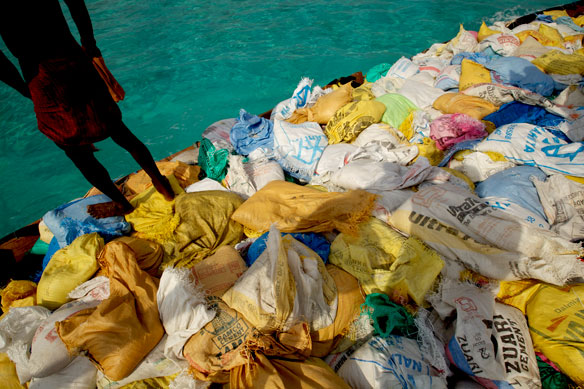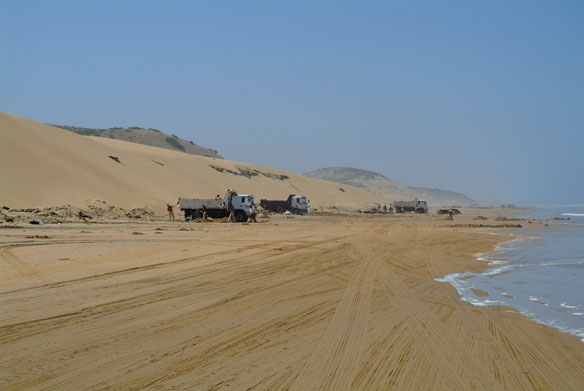
Sand miners, Maldives.
As of 2011-2012, when investigative filmmaker Denis Delestrac and team, were first collecting and unveiling unpublished sand mining datas and information from the professionals involved, the Sand business was estimated to be a $70 billion industry, worldwide…!—Denis Delestrac (©-2013)
“Sand is the second most consumed natural resource, after water. The construction-building industry is by far the largest consumer of this finite resource. The traditional building of one average-sized house requires 200 tons of sand; a hospital requires 3,000 tons of sand; each kilometer of highway built requires 30,000 tons of sand… A nuclear plant, a staggering 12 million tons of sand…” Captions and Photograph by: “Sand Wars” Multi Award-Winning Filmmaker Denis Delestrac (©-2013).
Excerpts;
With the global demand for sand and gravel standing at 40 to 50 billion tonnes per year, a new report by UN Environment reveals that aggregate extraction in rivers has led to pollution, flooding, lowering of water aquifers and worsening drought occurrence.
The report Sand and sustainability: Finding new solutions for environmental governance of global sand resources presents how shifting consumption patterns, growing populations, increasing urbanization and infrastructure development have increased demand for sand three-fold over the last two decades. Further to this, damming and extraction have reduced sediment delivery from rivers to many coastal areas, leading to reduced deposits in river deltas and accelerated beach erosion.
“We are spending our sand ‘budget’ faster than we can produce it responsibly. By improving the governance of global sand resources, we can better manage this critical resource sustainably and truly demonstrate that infrastructure and nature can go hand in hand,” said Joyce Msuya, Acting Executive Director of UN Environment.
According to the report, sand and gravel resources are the second-largest resource extracted and traded by volume after water. With sand extraction regulated differently around the world, important regions for biodiversity and ecosystems are made more vulnerable by challenges in the local implementation of these regulations. A growing trend of unsustainable and illegal extraction in marine, coastal and freshwater ecosystems makes this a sustainability challenge with a display of the various extraction impacts on terrestrial, riverine and marine environments.
Sand extraction is fast becoming a transboundary issue due to sand extraction bans, international sourcing of sand for land reclamation projects and impacts of uncontrolled sand extraction beyond national borders. International trade in sand and gravel is growing due to high demand in regions without local sand and gravel resources and is forecast to rise 5.5 per cent a year with urbanization and infrastructure development trends.
Unsustainable sand extraction does not only impact the environment but can also have far-reaching social implications. Sand removal from beaches can jeopardize the development of the local tourism industry, while removing sand from rivers and mangrove forests leads to a decrease of crab populations—negatively affecting women whose livelihood depends on the collection of crabs.
The report further alerts that to meet demand in a world of 10 billion people without harming the environment, effective policy, planning, regulation and management will be needed. Currently, sand extraction and use is defined by its local geography and governance context and does not have the same rules, practices and ethics worldwide. The report aims to be a starting point from which a productive global conversation on sand extraction can begin.
To curb irresponsible and illegal extraction, the report suggests a customization of existing standards and best practices to national circumstances. It also points towards investing in sand production and consumption measurement, monitoring and planning, and further suggests establishing dialogue between key players and stakeholders in the sand value chain based on transparency and accountability.
This report was presented to policymakers at the United Nations Environment Assembly where a new Mineral Resource Governance Resolution was adopted, including call for actions on sustainable sand management.”
Original Article; UN (05-07-2019)
The Conservation Crisis No One Is Talking About, TakePart (09-21-2016)
Beaches around the world are disappearing. No, the cause isn’t sea-level rise, at least not this time. It’s a little-known but enormous industry called sand mining, which every year sucks up billions of tons of sand from beaches, ocean floors, and rivers to make everything from concrete to microchips to toothpaste…
The sands of time; The New York Times (12-15-2017)
Human intervention to control beach depth is often futile. Repeated studies have found that sand pumped onto beaches in order to protect coastal property may be washed out by a storm or two. These beaches commonly lose all the new sand in five years or so…
Sand, Rarer Than One Thinks: A UNEP report (GEA-March 2014)
Despite the colossal quantities of sand and gravel being used, our increasing dependence on them and the significant impact that their extraction has on the environment, this issue has been mostly ignored by policy makers and remains largely unknown by the general public.
In March 2014 The United Nations released its first Report about sand mining. “Sand Wars” film documentary by Denis Delestrac – first broadcasted on the european Arte Channel, May 28th, 2013, where it became the highest rated documentary for 2013 – expressly inspired the United Nations Environment Programme (UNEP) to publish this 2014-Global Environmental Alert.
Sand Wars, An Investigation Documentary, By Award-Winning Filmmaker Denis Delestrac (©-2013)
Is sand an infinite resource? Can the existing supply satisfy a gigantic demand fueled by construction booms? What are the consequences of intensive beach sand mining for the environment and the neighboring populations…? This investigative documentary takes us around the globe to unveil a new gold rush and a disturbing fact: the “Sand Wars” have begun…
Global Sand Mining: Learn More, Coastal Care
BE THE CHANGE:
PETITION: Take Action To End Global Beach Sand Mining, Coastal Care

Illegal beach sand mining, near Tangier, Morocco. Photograph: © SAF — Coastal Care








